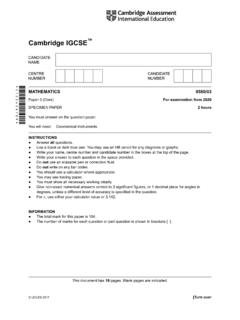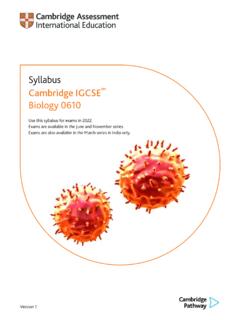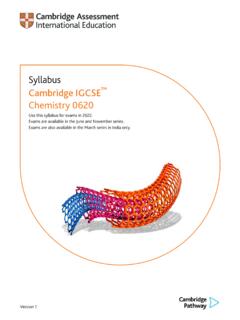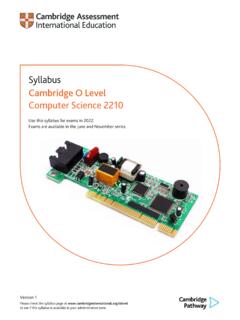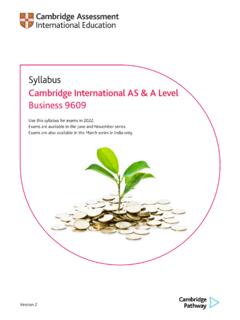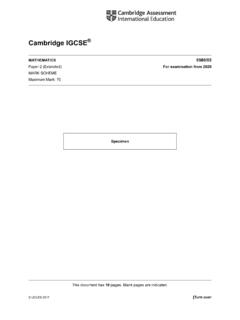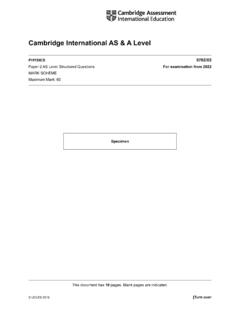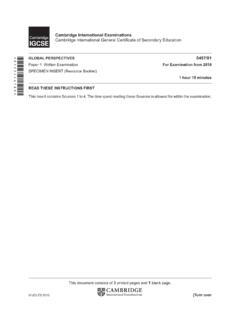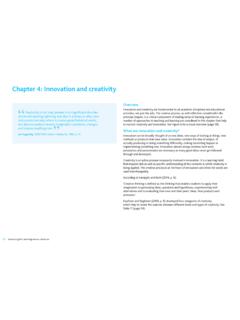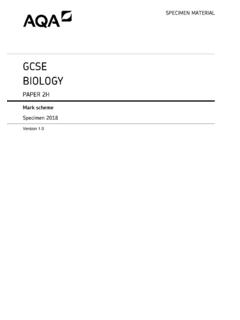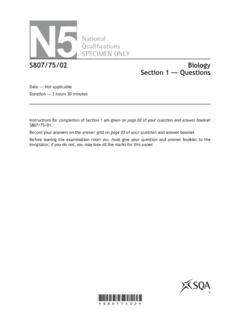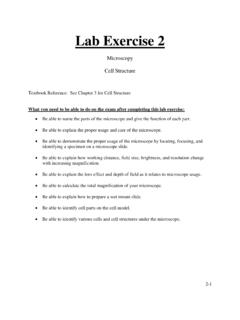Transcription of Cambridge International AS A Level
1 Cambridge International AS & A Level biology 9700/05. paper 5 Planning, Analysis and Evaluation For examination from 2022. MARK SCHEME. Maximum Mark: 30. specimen This document has 10 pages. Blank pages are indicated. UCLES 2019 [Turn over Generic Marking Principles These general marking principles must be applied by all examiners when marking candidate answers. They should be applied alongside the specific 9700/05. content of the mark scheme or generic Level descriptors for a question. Each question paper and mark scheme will also comply with these marking UCLES 2019. principles. GENERIC MARKING PRINCIPLE 1: Marks must be awarded in line with: the specific content of the mark scheme or the generic Level descriptors for the question the specific skills defined in the mark scheme or in the generic Level descriptors for the question the standard of response required by a candidate as exemplified by the standardisation scripts.]
2 GENERIC MARKING PRINCIPLE 2: Marks awarded are always whole marks (not half marks, or other fractions). GENERIC MARKING PRINCIPLE 3: Marks must be awarded positively: Page 2 of 10. specimen . marks are awarded for correct/valid answers, as defined in the mark scheme. However, credit is given for valid answers which go beyond the scope of the syllabus and mark scheme, referring to your Team Leader as appropriate marks are awarded when candidates clearly demonstrate what they know and can do marks are not deducted for errors marks are not deducted for omissions answers should only be judged on the quality of spelling, punctuation and grammar when these features are specifically assessed by the question as indicated by the mark scheme. The meaning, however, should be unambiguous. Cambridge International AS & A Level Mark Scheme . GENERIC MARKING PRINCIPLE 4: Rules must be applied consistently in situations where candidates have not followed instructions or in the application of generic Level descriptors.
3 GENERIC MARKING PRINCIPLE 5: Marks should be awarded using the full range of marks defined in the mark scheme for the question (however; the use of the full mark range may be limited according to the quality of the candidate responses seen). from 2022. For examination GENERIC MARKING PRINCIPLE 6: 9700/05. Marks awarded are based solely on the requirements as defined in the mark scheme. Marks should not be awarded with grade thresholds or grade UCLES 2019. descriptors in mind. Science-Specific Marking Principles 1 Examiners should consider the context and scientific use of any keywords when awarding marks. Although keywords may be present, marks should not be awarded if the keywords are used incorrectly. 2 The examiner should not choose between contradictory statements given in the same question part, and credit should not be awarded for any correct statement that is contradicted within the same question part.
4 Wrong science that is irrelevant to the question should be ignored. 3 Although spellings do not have to be correct, spellings of syllabus terms must allow for clear and unambiguous separation from other syllabus terms with which they may be confused ( ethane / ethene, glucagon / glycogen, refraction / reflection). 4 The error carried forward (ecf) principle should be applied, where appropriate. If an incorrect answer is subsequently used in a scientifically correct way, the candidate should be awarded these subsequent marking points. Further guidance will be included in the mark scheme where necessary and any exceptions to this general principle will be noted. Page 3 of 10. 5 List rule' guidance (see examples below). specimen . For questions that require n responses ( State two reasons ): The response should be read as continuous prose, even when numbered answer spaces are provided Any response marked ignore in the mark scheme should not count towards n Incorrect responses should not be awarded credit but will still count towards n Read the entire response to check for any responses that contradict those that would otherwise be credited.
5 Credit should not be awarded for any responses that are contradicted within the rest of the response. Where two responses contradict one another, this should Cambridge International AS & A Level Mark Scheme . be treated as a single incorrect response Non-contradictory responses after the first n responses may be ignored even if they include incorrect science. from 2022. For examination 6 Calculation specific guidance 9700/05. Correct answers to calculations should be given full credit even if there is no working or incorrect working, unless the question states show UCLES 2019. your working'. For questions in which the number of significant figures required is not stated, credit should be awarded for correct answers when rounded by the examiner to the number of significant figures given in the mark scheme. This may not apply to measured values.
6 For answers given in standard form, ( a 10n) in which the convention of restricting the value of the coefficient (a) to a value between 1. and 10 is not followed, credit may still be awarded if the answer can be converted to the answer given in the mark scheme. Unless a separate mark is given for a unit, a missing or incorrect unit will normally mean that the final calculation mark is not awarded. Exceptions to this general principle will be noted in the mark scheme. 7 Guidance for chemical equations Multiples / fractions of coefficients used in chemical equations are acceptable unless stated otherwise in the mark scheme. State symbols given in an equation should be ignored unless asked for in the question or stated otherwise in the mark scheme. Page 4 of 10. specimen . Mark scheme abbreviations: ; separates marking points / separates alternatives within a marking point R reject I ignore mark as if this material was not present A accept (a less than ideal answer which should be marked).
7 COND indicates mark is conditional on previous marking point Cambridge International AS & A Level Mark Scheme . OWTTE or words to that effect (accept other ways of expressing the same idea). AW alternative wording (where responses vary more than usual). UNDERLINE actual word given must be used by candidate (grammatical variants accepted). max indicates the maximum number of marks that can be awarded ECF credit a correct statement that follows a previous wrong answer MP marking point (with relevant number). ( ) the word / phrase in brackets is not required, but sets the context ORA or reverse argument from 2022. For examination Examples of how to apply the list rule State three reasons .. [3]. 9700/05. UCLES 2019. A F (4 responses). 1. Correct 1. Correct . 2. Correct 2 2. Correct . 2. 3. Wrong 3. Correct . CON (of 3.) (discount 3). B (4 responses).
8 1. Correct, Correct , G (5 responses). 1. Correct . 2. Correct 3. 2. Correct . 3. Wrong ignore 3. 3. Correct . C (4 responses) Correct ignore CON (of 4.) ignore 1. Correct . Page 5 of 10. 2. Correct, Wrong , 2 H (4 responses). specimen . 3. Correct ignore 1. Correct . 2. Correct . D (4 responses) 2. 3. CON (of 2.) (discount 2). 1. Correct . Correct . 2. Correct, CON (of 2.) , (discount 2) 2. I (4 responses). 3. Correct . Cambridge International AS & A Level Mark Scheme . 1. Correct . E (4 responses) 2. Correct . 2. 1. Correct . 3. Correct . 2. Correct 3 CON (of 2.) (discount 2). 3. Correct, Wrong . from 2022. For examination Question Answer Marks 1(a)(i) type(s) of enzyme / endoprotease or exoprotease ; 1. 9700/05. UCLES 2019. 1(a)(ii) temperature + pH + time intervals between samples ; 1. 1(a)(iii) method must match the related variable 2.
9 Any two from: temperature use a water-bath / incubator ;. pH use a (named) buffer ;. time intervals use a stop-clock / stop-watch / timer / AW ;. 1(a)(iv) idea of: 1. two (successive) chromatograms give the same results or no more change in, results / chromatograms / spots ;. Page 6 of 10. specimen . Cambridge International AS & A Level Mark Scheme . from 2022. For examination Question Answer Marks (1)(b) accept marks from a labelled diagram 8. 9700/05. UCLES 2019. any eight from: max 7 from marking points 1 12. 1 ref. to drawing or using, a base line / line of origin ; R if using pen or ink to draw base line 2 ref. to suitable method of applying sample to give a small spot (on the chromatography paper ) ;. 3 idea of chromatograms using hydrolysed extracts of both enzymes ;. 4 ref. to same number of applications applied to origin.
10 5 idea of concentrating the extract ; b y drying between adding spots or concentrating the extract by evaporation before use 6 ref. to placing in solvent so that the Level of solvent is below the, origin line / sample ;. Page 7 of 10. specimen . 7 ref. to covering to, prevent evaporation / maintain a saturated environment ;. 8 ref. to running all chromatograms for same time or ref. to running all chromatograms until same distance moved by solvent front ;. R if allow to run off the end 9 ref. to drying before spraying with dye ;. Cambridge International AS & A Level Mark Scheme . 10 idea of running at least 3 chromatograms for each enzyme ;. 11 ref. to taking mean of distances travelled by each spot or taking mean of Rf values ;. from 2022. For examination Question Answer Marks 1(b) 12 any one from: 9700/05. UCLES 2019. ref. to flammable solvents and no naked flames.
